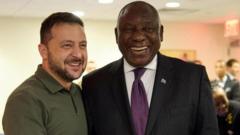As President Trump embarks on an audacious plan to secure multiple global trade deals over an unprecedented short timeframe, the complexity of such agreements, particularly with major economies, casts doubts on unfolding success.
Trump's Ambitious Trade Agenda Faces Challenges in Deal-Making

Trump's Ambitious Trade Agenda Faces Challenges in Deal-Making
President Trump aims for rapid trade agreements, yet experts warn of hurdles with traditional negotiation timelines.
In a race against time, President Trump has set his sights on negotiating a myriad of international trade deals within the looming 11-week deadline. The urgency has prompted countries like Japan, South Korea, and India to engage quickly in talks, eager to stave off the prospect of hefty tariffs imposed by the U.S. However, trade experts stress that the ambitious timeline for reaching these agreements is impractical, since traditional trade negotiations can span months or even years.
Using tariffs as a form of leverage, Trump’s trade adviser Peter Navarro has vowed to finalize “90 deals in 90 days.” Nonetheless, this approach has resulted in market turbulence and financial distress for various businesses—particularly those reliant on imports from China. The ongoing trade conflict has caused a significant downturn in U.S.-China trade, with sweeping tariffs leading to a concerning number of potential bankruptcies among smaller companies.
Many officials within the Trump administration are reportedly recognizing the untenability of the existing trade situation with China and are exploring strategies to ease tariffs. There are fears about the ongoing volatility in the stock market, which has seen some of its sharpest declines in years, correlated with the administration’s trade policies. Since Trump took office on January 20, the S&P 500 has dropped by 10 percent.
Recently, Trump hinted at a possible reduction of the striking 145 percent tariff on Chinese goods, stating, “It won’t be anywhere near that high… It’ll come down substantially. But it won’t be zero.” As negotiations progress, it remains to be seen whether the administration can blend swift action with the complexities inherent in international trade dynamics.























